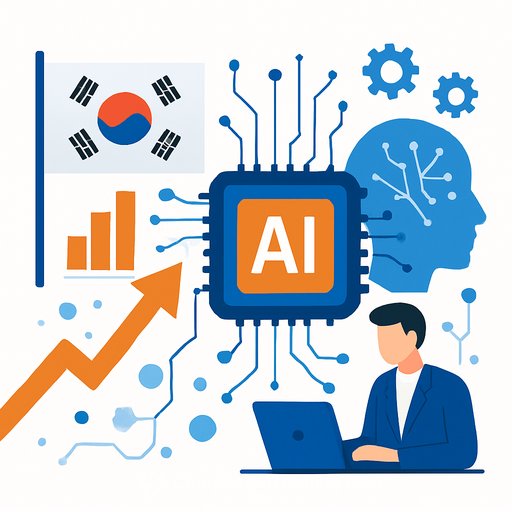Nvidia's 260,000-GPU Deal Puts South Korea on a Fast Track to Sovereign AI
South Korea has secured one of the largest AI hardware agreements to date: 260,000 Nvidia GPUs allocated across the government and four major firms-Samsung Electronics, SK Group, Hyundai Motor, and Naver. The deal was finalized during a meeting between Nvidia CEO Jensen Huang and President Lee Jae Myung at the APEC summit in Gyeongju.
Valued at roughly 14 trillion won (about $10 billion), the agreement targets Korea's "sovereign AI" push-building domestic large language models and infrastructure rather than leaning on foreign platforms. Huang called Korea's industrial base "unmatched anywhere in the world," adding the country "can become the global center of AI."
Who Gets What
- Government: 50,000 GPUs
- Samsung Electronics: 50,000 GPUs
- SK Group: 50,000 GPUs
- Hyundai Motor: 50,000 GPUs
- Naver Cloud: 60,000 GPUs
The chips are part of Nvidia's latest Blackwell series, built for large-scale training and inference. For context on the architecture, see Nvidia's overview of Blackwell GPUs here. The agreement was reached on the sidelines of the Asia-Pacific Economic Cooperation meetings; more on APEC's role can be found here.
Why This Matters for Public Sector Leaders
This scale of compute addresses Korea's GPU shortfall and clears a path for domestic model training, sector-specific AI services, and national security use cases. It also reduces exposure to external platform changes, pricing swings, and export policy shocks.
For agencies, this move signals where budgets, infrastructure, and talent will be pulled next: energy, data centers, and model governance. Expect demand for shared national compute and faster procurement cycles tied to AI programs.
Deployment Plans at a Glance
- Samsung: Building an "AI semiconductor factory" where AI assists across chip design and production workflows.
- SK Group: Advancing semiconductor R&D, cloud services, and AI agent development.
- Hyundai Motor: Standing up an "AI mobility factory" to train advanced models for autonomous driving and robotics.
- Naver Cloud: Creating a "physical AI platform" to digitally mirror complex sites like shipyards and fabs.
Supply Chain and Standards
The partnership deepens ties with Korea's memory leaders. Samsung Electronics and SK Hynix supply the high-bandwidth memory used in Nvidia GPUs, and analysts estimate that over two million HBM units could be involved to meet this deal's needs. This positions both companies well for the next wave of HBM4 and beyond.
Huang emphasized balance rather than picking sides between suppliers: "I don't need to choose between them… We need both-and I'm 100 percent confident we'll develop HBM4, HBM5, and beyond together as long-term partners."
Policy and Procurement Takeaways
- Capacity planning: Map projected compute demand by mission area (defense, health, transportation, industrial policy) and prioritize workloads that justify large-scale training.
- Data center readiness: Validate energy, cooling, and floor space for dense GPU clusters. Plan phased expansions tied to delivery windows.
- Interoperability: Standardize on container orchestration, observability, and networking to avoid silos across ministries and SOEs.
- Data governance: Lock in policies for sensitive datasets, model provenance, evaluation, and incident reporting before scaling access.
- Talent: Budget for AI engineers, MLOps, cybersecurity, and safety evaluation teams. Upskill existing staff to manage and audit large models.
- Risk management: Track export rules and supply constraints. Build contingencies for staggered delivery and component substitutions.
What to Watch Next
- Delivery sequencing: How the 260,000 units are scheduled and distributed across public and private recipients.
- Shared national compute: Whether Korea formalizes pooled infrastructure for agencies and regulated industries.
- Model performance and cost: Benchmarks for domestic LLMs and domain models versus commercial alternatives.
- Industrial twins: Output from Naver Cloud's "physical AI platform" and how it supports safety, compliance, and productivity gains in heavy industry and semiconductors.
For Public Sector Teams Preparing Now
Stand up a cross-agency task group to coordinate infrastructure, data access, and procurement. Start with 6-12 week pilots on priority use cases, then scale what works.
If your team needs structured upskilling by job function, explore curated options here.
Context
The meeting in Gyeongju brought together President Lee Jae Myung, Nvidia CEO Jensen Huang, Samsung Chairman Lee Jae-yong, SK Group Chairman Chey Tae-won, Hyundai Motor Group Executive Chair Euisun Chung, and Naver founder Lee Hae-jin. The agreement signals Nvidia's deeper push into Asia as it diversifies beyond China amid U.S. export limits on advanced chips.
Your membership also unlocks:






